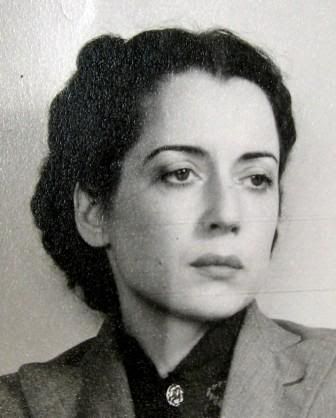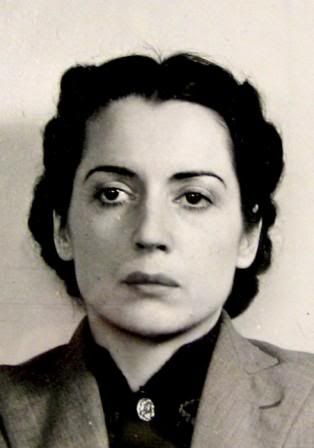These quiet shores remained relatively peaceful throughout most
of the war, although there are several stories of German spies
trying to infiltrate our country. One such story takes place along
the Portgordon coastline and begins in the early hours of the
morning on 30th September in 1940. A Blom and Voss flying boat
arrived from the then Nazi occupied Stavanger in Norway and landed
offshore somewhere between Portgordon and Buckie. Three passengers
disembarked, Vera Eriksen Karl Theo Drucke and Werner Heinrich
Walti who then came ashore in a dinghy, their luggage laden with
the tools of their trade. The trio were working for German
Intelligence on “Operation Lena” and were en route to
London to assume their new identities. Their leader, Vera Eriksen,
was to assume the role of the long-lost niece of an elderly Italian
Countess living in Kensington. Karl Drucke was posing as a French
refugee from Belgium, named Francois de Deeker and Walti was to
pose as a Swiss National.
The three were instructed to cycle the 600 miles to London, but as
their bicycles were lost in the choppy seas during the transfer;
they split up, with Vera Eriksen and Karl Drucke heading towards
Portgordon, whilst Walti set off in the direction of Buckie.
Eriksen and Drucke walked to Portgordon railway station and it is
reported that locals noticed their “guttural accents”
whilst the pair walked through the village. The Station Master John
Donald and porter, John Geddes noticed the two strangers at the
railway station around 7.30am. Their suspicions were first aroused
when Eriksen asked the name of the station, as the sign had been
blacked out, as had all place names in the UK. Drucke then asked
for tickets to nearby Forres by calling it “Forrest”
and the staff became more dubious. Producing a wallet, crammed full
of banknotes, Drucke further compounded his obvious lack of local
knowledge by handing over far too much money. The Station Master
also noted that the pairs’ shoes and trousers were completely
soaked, so he instructed John Geddes to keep them talking whilst he
contacted local Police Constable, Robert Grieve. On arrival PC
Grieve immediately asked to see Eriksen and Drucke’s identity
cards, noticing that the cards were made out in
“continental” writing.
After a brief interrogation, the pair were taken to the police
station where PC Grieve telephoned his superior, Inspector John
Simpson at nearby Buckie. Surprisingly the pair were not put in
cells, but were in fact treated hospitably, with Mrs Grieve even
making Vera Eriksen a cup of tea which she drank in their sitting
room. On his arrival, Inspector Simpson asked Drucke to identify
himself, but Vera Eriksen informed the Inspector that he
couldn’t speak English. After carrying out a quick body
search, Inspector Simpson discovered a box containing nineteen
rounds of revolver ammunition. He also checked their identity cards
and noted that the numbers were written in the European style.
Eriksen, keen to cover her true identity, gave the Inspector her
cover story and informed him that she was a 27yr old widow from
Denmark. She said they had spent a night in a hotel in Banff and
had taken a taxi to Portgordon, being dropped off a mile before the
station.
Major Peter Perfect, the Regional Security Liason Officer was
summoned from Edinburgh and the two were arrested at Banff Police
Station, after Vera Eriksen turned them both in. A thorough search
of their luggage revealed the true intent of their trip when
several items of espionage were discovered, including; a pistol and
ammunition, a wireless and accessories, a torch marked “Made
in Bohemia”, batteries, a coding device, graph paper, English
money and a list of place names that turned out to be airfields. It
is said, however, that a German delicacy, unheard of in wartime
Britain was the source of their downfall when a half eaten German
sausage was found in their possession.
A search of the coastline was ordered and later that morning,
Buckie Coastguard spotted an object floating a ¼ mile out to sea.
Coastguard Addison and The Harbourmaster recovered the object,
which was a pair of bellows and also discovered a rolled up rubber
dingy further down the shore.
Meanwhile, the third agent, Walti was having a little more success
and had managed to get as far as Aberdeen after heading into
Buckie, with his suitcase containing a radio transmitter. The
Aberdeen police were alerted to the situation and confirmation was
given that someone matching Walti’s description had boarded
the 1pm train to Edinburgh Waverly. On arriving at Waverly, Walti
found he had some time to spare before his next train, so went to
the hairdressers for a shave and spent some time in the cinema.
Unbeknownst to him, Superintendant, Willie Merrilees of Special
Branch and several police officers had disguised themselves as
railway porters and were awaiting his return. When he arrived to
collect his left luggage, he was ambushed. When searched, Walti was
found to be armed with a loaded pistol and a flick knife.
All three Agents were interrogated by Lieutenant-Colonel
Hinchley-Cooke at New Scotland Yard and eventually signed
confessions in March 1941. Drucke and Walti were tried “in
camera” on 12th June 1941, were found guilty and sentenced to
death, finally being hanged at Wandsworth prison on 6th August
1941, almost a year since that first night on the beach.
Vera Eriksen somehow managed to avoid being present in court and
summarily avoided execution. Rumours and stories surrounding her
evading trial and execution remain to this day. One such rumour
surrounds the fact that she may have given birth to a son during an
earlier mission to Britain in 1938. It is said that her then
husband, German Officer, Hans Friedrich von Wedel, was not the
father, but that it was a prominent member of the British
establishment. The child, now a British Citizen, grew up in an
orphanage in Essex and it is believed he was taken to see his
mother during her time at Holloway. Another rumour holds that she
was a double agent all along, recruited by MI6 in Paris in the
thirties, but as large parts of her case file have been removed,
the full truth may never be known.
At the end of the war, Vera Eriksen was to be deported to Germany
but due to an “administrative blunder” in October 1945
the M15 "mislaid" her and she disappeared, never to be heard from
again. However, some stories say she may have even changed her name
and settled on the Isle of Wight. Sixty-six years after her capture
in September 1940, MI5 still refuse to release all their files on
‘the Beautiful Spy’.


The three bicycles were never found, and it is said that they may
have also lost a small plastic container when coming ashore. The
location of this secret “cache” was known only to Vera
Eriksen. Pre-empting her capture by the authorities, she managed to
send a coded radio transmission, informing the German Intelligence
of the co-ordinates of the cache’s location. The message was
as follows:
ROYFHWSRDZBMJUWLXLGIMYDASVLPPAYLWPLYVMICGTVDCWILUNYVILICCYQLCRUODPCYICLL
ZGCYUCKYJYYPFOOYPAYHUJZVIAUGNBWZYGRIAMM
Today, the cache location can be reached either by walking along
the coastline from Lossiemouth, parking at N57° 42.837 W003°
16.733, or from the forest walks on the B9103, parking at N57°
41.235 W003° 14.821. The cache is within 3.5km of either parking
sites.
PLEASE NOTE THE CO-ORDINATES FOR THIS CACHE ARE FOR A PARKING AREA
ONLY AND ARE NOT THE CACHE LOCATION.
Our thanks to the Forestry Commission for their permission to place
this cache on their land.
Check out Moray Geocachers on Facebook
https://www.facebook.com/pages/Moray-Geocachers/126001280851564